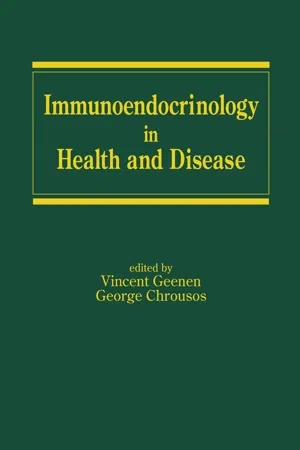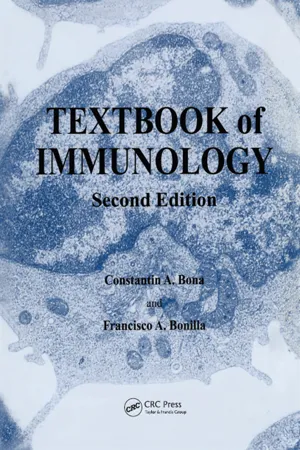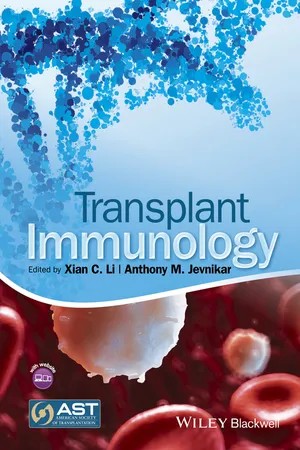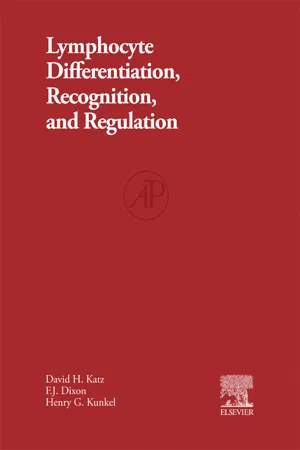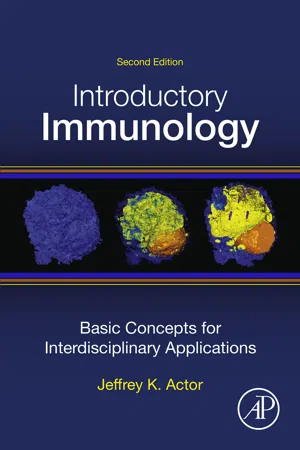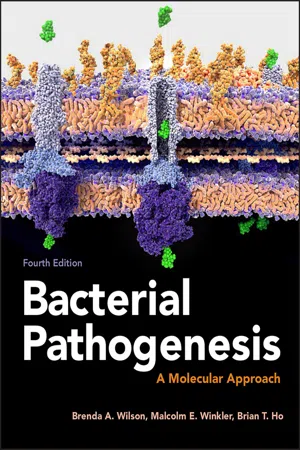Biological Sciences
T Cell Immunity
T cell immunity refers to the body's defense mechanism mediated by T lymphocytes, a type of white blood cell. T cells play a crucial role in recognizing and destroying infected or abnormal cells, as well as coordinating the immune response. This process is essential for protecting the body against pathogens and for maintaining overall immune system function.
Written by Perlego with AI-assistance
Related key terms
Related key terms
1 of 4
Related key terms
1 of 3
10 Key excerpts on "T Cell Immunity"
- eBook - ePub
- Vincent Geenen(Author)
- 2004(Publication Date)
- CRC Press(Publisher)
1A Global View of Immunological Development and Biology
RACHEL ALLEN and ANNE COOKECambridge University, Cambridge, United KingdomAn effective immune response coordinates the action of organs, circulating cells, and soluble components as an integrated system to eradicate foreign material encountered within the body. Many of these agents are already present within the circulation, under tight regulation yet able to migrate to the source of infection to mount a rapid response upon challenge. Others are stationed within lymphoid organs, awaiting stimulation to direct a targeted immune response. This chapter aims to provide a general overview of how our immune system develops, encompassing innate and adaptive (or acquired) aspects of immunity, their complex interactions, and the regulatory mechanisms that control their actions.I. KEY PLAYERS OF THE IMMUNE SYSTEM
A defining characteristic of vertebrate immune systems is the production of a pathogenspecific response that can be swiftly recalled with an increased potency upon repeated challenge. By directing these specificity and memory functions, B and T lymphocytes compose the main cellular agents of the adaptive immune response.A. Key Cell Types
1. T Lymphocytes
T lymphocytes provide adaptive immunity at a cellular level. The antigen-specific T-cell receptor (TCR) recognizes short peptide fragments displayed on the surface of potential target cells by specialized antigen presenting protein complexes (see Sec. I.C ). Distinct populations of T lymphocytes are responsible for various effector functions (Fig. 1 ). Cytotoxic T lymphocytes (CTL) (also known as CD8+ T cells due to their characteristic expression of the CD8 co-receptor) are responsible for the lysis of infected or transformed cells. To enable their lytic role, the cytoplasm of a cytotoxic T lymphocyte contains enzyme-rich granules, whose components are released to form pores in the target cell membrane and trigger programmed cell death (apoptosis). Cytotoxic T lymphocytes can also induce lysis through activation of death receptors such as Fas or TNFR on their target cell surface. The primary functions of helper T (TH ) lymphocytes (also known as CD4 T cells) are mediated through the action of secreted agents known as cytokines and surface molecules such as CD40L. The TH cell population may be further divided into TH O, TH 1, TH 2, TH - eBook - ePub
Cancer Immunotherapy
Immune Suppression and Tumor Growth
- George C. Prendergast, Elizabeth M. Jaffee(Authors)
- 2013(Publication Date)
- Academic Press(Publisher)
nonresponsiveness to self. Understanding how these features of the adaptive branch of the immune system are achieved, and how to effectively exploit these characteristics in order to protect from infection or fight disease, has been the focus of intensive research for much of the last century and through today. There are two types of adaptive immune responses: humoral responses and cell-mediated responses, which are directed by the B cells and the T cells, respectively. The humoral response is characterized by the production of soluble immunoglobulins or antibodies. These proteins have a number of specific effector functions that will be described in a bit more detail below, but ultimately they bind to target antigens and mediate either their destruction or clearance from the body, or in the case of molecules like toxins or viruses, antibody binding can render them inactive. Cell-mediated responses are a bit more diverse and include the direct killing of target cells, either virally infected or cancerous cells by specialized T cells or NK cells, as well as the production of cytokines by T cells and the subsequent activation of other cells.V Lymphocyte Recognition of Antigen
The cells of the immune system continually circulate, constantly searching for invading microbes, other dangerous invaders or altered self-cells. Lymphocytes that have entered the periphery and have not yet encountered antigens are said to be naïve, and these cells have a finite lifespan. To initiate an immune response, either humoral or cell-mediated, a specific lymphocyte must be appropriately stimulated by antigenic encounter. This ensures that lymphocytes do not differentiate into effector cells when their target is not present. Thus, the first step of an immune response is specific antigen recognition by a given B or T cell.One of the key features of both B and T cells is that individual lymphocytes express a single, specific antigen receptor on their surface. In the case of B cells, this antigen receptor is a membrane bound immunoglobulin molecule (surface Ig, or sIg) [29 ,30 ], while for T cells it is a membrane bound heterodimeric protein called the T-cell receptor (TCR) [31 ]. The antigen receptor on each lymphocyte is unique and capable of binding to a single antigenic determinant, which is termed an epitope. Antigen binding, which is mediated by noncovalent interactions between the amino acids of the antigen-binding site of the antigen receptor and the epitope, initiates a biochemical signaling cascade that ultimately leads to the “activation” of the lymphocyte. Importantly, however, sIg and the TCR have short cytoplasmic tails, and thus they cannot transduce an intracellular biochemical signal. To do so, both types of antigen receptors rely on the association with other molecules, the Ig-α and Ig-β proteins on B cells and the proteins of the CD3 complex on T cells. Following appropriate stimulation with foreign antigen, activated B and T cells divide, generating multiple copies of themselves, and these daughter cells go on to differentiate into functional effector cells and long-lived memory cells (Figure 2.2 ). Importantly, the antigen specificity of the daughter cells, both the effectors and the memory cells, is identical to that of the original lymphocyte. This behavior, the ability of a single cell to recognize foreign antigen and respond by generating multiple effector and memory cells with the same specificity, is termed the clonal selection theory and it is a central pillar in our understanding of the immune system [32 - eBook - ePub
- Constantin A. Bona, Francisco A. Bonilla(Authors)
- 2019(Publication Date)
- CRC Press(Publisher)
Chapter 6T Cells:Regulation and Cellular Immunity
T lymphocytes mature in the thymus. T cells regulate the development, proliferation and activity of B cells, T cells, and other cells participating in immune responses; they are also effectors of antigen-specific cell-mediated immunity (CMI). CMI is important in the elimination of cells infected with pathogens which replicate intracellularly (e.g., viruses, rickettsia, and some bacteria) and cells exhibiting aberrant cytodifferentiation (neoplastic cells). CMI also destroys allogeneic cells (graft rejection).Several important characteristics distinguish T and B cells. First, B cell receptors exist both on the cell surface, where they generate activating signals, and are secreted as soluble effector molecules. T cell receptors do not exist intact in soluble form. (Fragments may be components of soluble suppressor factors, see below.) Second, B cell immunoglobulin recognizes native macromolecules free in solution, and may bind to protein, glycoprotein, polysaccharide, nucleic acid, or lipid antigens. T cell receptors require a cognate interaction, and recognize only fragments (peptides) of (glyco)protein antigens on the surfaces of antigen presenting cells (APCs), also called accessory cells. With respect to T cell antigen recognition, APCs have at least two main functions: they ingest antigen and process it; they then form a complex of peptide fragments with major histocompatibility complex (MHC) antigens and present it to T cells. Note the distinction between the processed antigen (peptides), and the histocompatibility antigen with which it becomes associated in order to be recognized. This association is the basis of the MHC restriction of antigen recognition. The genetics and structure of MHC antigens, and details of antigen presentation are discussed in Chapter 8 .Expression of the T cell receptor and several associated molecules on the cell surface is essential to the process of T cell development. We will first examine the structure and genetics of the receptor and its companion surface proteins, before entering a detailed discussion of T cell differentiation. - eBook - ePub
- Xian C. Li, Anthony M. Jevnikar(Authors)
- 2015(Publication Date)
- Wiley-Blackwell(Publisher)
CHAPTER 6 T cells and the principles of immune responsesJonathan S. Maltzman1 , Angus Thomson2 , and David M. Rothstein21 Department of Medicine, University of Pennsylvania, Philadelphia, PA, USA 2 Department of Medicine, Surgery and Immunology, Starzl Transplant Institute, University Pittsburgh, Pittsburgh, USACHAPTER OVERVIEW
- T cells must be activated first before becoming effector cells.
- T cell activation is controlled by multiple signals, which include signals from the TCR, costimulatory molecules, and cytokine receptors.
- There are distinct phases of T cell response including proliferation, differentiation, apoptosis, and memory generation, all of which are tightly regulated by multiple mechanisms.
- T cells exhibit either effector or regulatory properties, both are required for immunity and homeostasis of the immune system.
- The balance of effector and regulatory responses determines outcomes of organ transplants.
Introduction
T cells are central to productive immune responses. The importance of T cells is underscored by the fact that mice lacking T cells exhibit gross immunodeficiency and fail acutely to reject allografts. In general, productive T cell activation is controlled by three distinct sets of signaling pathways, which are delivered by T cell receptors (TCRs), costimulation, and cytokine receptors. These signaling pathways collectively control activation, differentiation, and effector function of T cells during primary immune responses. Activated T cells then undergo phases of contraction and memory transition in which most activated T cells die of apoptosis, leaving behind a small proportion of cells as memory cells. This transition from short-lived effector T cells to long-lived memory T cells is tightly regulated by selective cytokines, costimulatory molecules, and certain metabolic pathways. Some activated T cells are also converted to regulatory cells that prevent overstimulation of the immune system and maintain immune homeostasis. This chapter will describe the principles of T cell responses and how such responses are targeted to promote transplant survival. - David H. Katz, F. J. Dixon, Henry G. Kunkel(Authors)
- 2014(Publication Date)
- Academic Press(Publisher)
VII Immunological Specificity of Immunocompetent Lymphocytes Publisher Summary There is now a vast amount of data which provides absolute proof that both T and B lymphocytes are capable of manifesting immunological specificity. This is exemplified by the fact that specificity exists in immune responses characteristic of each cell population—thus, cell-mediated immunity such as delayed hypersensitivity, which is predominantly a function of T cells, and antibody production, which is mediated by B cells are specific events in the immune system. In immune responses to T cell-independent antigens (see Chapter IX) in which B cells develop antibody responses in the relative absence of T cell function, such cells truly reflect specificity for the antigens involved. The situation is somewhat more complex in humoral immune responses to antigens where T and B cell cooperative interactions are required (see Chapter X), but conclusive evidence exists that each of the respective cell classes participating in such responses manifest specificity for antigenic determinants stimulating the response- eBook - ePub
Exploring Immunology
Concepts and Evidence
- Gordon MacPherson, Jon Austyn(Authors)
- 2013(Publication Date)
- Wiley-Blackwell(Publisher)
5 T Cell-Mediated Immunity5.1 Introduction
An entirely new form of immunity, adaptive immunity, first evolved around the time of the Cambrian explosion. The first true lymphocytes appeared when fish developed jaws around 450 million years ago and adaptive immunity exists in all jawed vertebrates. Adaptive immunity has evolved in the presence of innate immunity, and depends in large part on the utilization of innate components for its activation and effector functions. In mice and men, innate immunity has now become largely subservient to the adaptive form in defence against infection. Why an additional form of immunity evolved is unknown, although presumably it could reflect an “arms race” between infectious agents and their hosts. Nevertheless, the ability of lymphocytes to recognize infectious agents may have been facilitated by mobile DNA elements (“jumping genes”) which are present in complex organisms. Stable insertion of such elements may have contributed to the evolution of a recognition system based on rearranging gene segments to generate multiple different antigen receptors. This system is used by T and B lymphocytes in vertebrates, and ultimately enables “anticipatory” recognition of antigens expressed by infectious agents.In this chapter, we examine immune responses that are primarily dependent on T lymphocytes. We start by noting that different populations of T cells have evolved, before focusing mainly on one conventional type, the αβ T cell (Section 5.1). We introduce classical major histocompatibility complex (MHC) molecules, which co-evolved with T lymphocytes and that enable them to recognize cells containing infectious agents, and describe how these molecules work (Section 5.2). (We also note that some related types of non-classical MHC molecules can enable non-conventional T cells to recognize and respond to infection.) We next examine the responses of conventional T cells, where they are activated and how they are triggered (Section 5.3), and what is known of how they can subsequently develop specialized functions that are needed to eliminate different types of infectious agents (Section 5.4). After this we discuss the role of the thymus in T cell development, including the generation of a huge repertoire of antigen receptors by random DNA changes – which is essential for the anticipatory recognition of infectious agents (Section 5.5). We also note how non-conventional T cells also develop within in the same organ. Finally we turn to therapy and briefly describe how T cells can be used in vaccines against infectious disease and potentially against malignant tumours (cancers) (Section 5.6). - eBook - ePub
Introductory Immunology
Basic Concepts for Interdisciplinary Applications
- Jeffrey K. Actor(Author)
- 2019(Publication Date)
- Academic Press(Publisher)
Chapter 4 T Lymphocytes: Ringleaders of Adaptive Immune Function Abstract This chapter will discuss the factors involved in the generation and establishment of the cellular response, which allows T lymphocytes to function as regulators of adaptive immunity. A discussion will examine the development and gene rearrangement of the antigen receptor, as well as thymic selection and subsequent maturation events. Presentation of antigen through major histocompatability molecules will be discussed as well, with an analysis of effector functions that allow T cells to regulate immunosurveillance responses to infectious assault. Keywords T lymphocyte; T cell receptor (TCR); Major histocompatibility complex (MHC); Human leukocyte antigen (HLA); T-helper cell; Cytotoxic T cell; Superantigen Chapter Focus To examine T lymphocytes as regulators of adaptive immune function. As such, they function as the primary effectors for cell-mediated immunity. An illustrative discussion will detail cellular development, moving from bone marrow precursors undergoing antigen receptor gene rearrangement through thymic selection and subsequent maturation events that permit antigen recognition. The process of antigen presentation by major histocompatability molecules will be covered, followed by an analysis of effector functions that allow T cells to regulate immunosurveillance toward infectious assault. T Lymphocytes: Specific and Long-Lasting Immunity The immune system must be able to recognize a large pool of antigens while maintaining the ability to distinguish between foreign material and the self. The T lymphocytes (T cells) confer response specificity using surface antigen receptors to facilitate the recognition of foreign material. These adaptive lymphocytes can respond to a wide array of antigens; however, the speed of response is slower than innate functions due to intermediate steps required from the time of infection to the mounting of a protective response - eBook - ePub
ASM Books
A Molecular Approach
- Brenda A. Wilson, Malcolm Winkler, Brian T. Ho(Authors)
- 2019(Publication Date)
- ASM Press(Publisher)
The Treg cells produce additional regulatory compounds that control the differentiation of Th0 cells. Treg cells maintain tolerance to self-antigens and modulate autoimmune responses and serve to suppress other immune cells, particularly once invading pathogens have been cleared from the body. Cytokines produced by Treg cells can direct the outcome of an immune response, tipping the balance between one dominated by a Th1 or a Th2 pathway (as in Box 4-3). Production of Antibodies by B Cells Two signals are required to activate B cells to differentiate into plasma cells and produce antibodies (Figure 4-10). This failsafe costimulatory mechanism makes sense, considering the dire consequences of not strictly controlling antibody production. One mechanism that activates B cells is the associated Th cells that mature in the thymus gland (thymus-dependent antigens). Resting B cells are not dividing, but they do express a single type of membrane immunoglobulin (mIg) on their surfaces. There are an enormous number (>10 10) of resting B cells displaying mIg molecules with different antigen specificities on their surfaces! The mIg molecules interact with a membrane-bound transducer protein to form the B cell receptor (BCR). When an antigen binds to the Fab regions of two mIg molecules, linking them together, a signal is sent to the B cell that can lead to cell proliferation, if a second signal is detected. The second signal is generated by endocytosis and presentation of the antigen on the MHC II-antigen complexes on the surface of the same B cell. The use of MHC II helps B cells find the activated Th cells that are displaying TCRs specific to the displayed antigen, which ensures specific responses to a particular antigen. Binding of a Th cell to the B cell involves a set of multiprotein contacts similar to those that occur between other APCs and T cells (Figure 4-10) - eBook - ePub
- Abul K. Abbas, Andrew H. Lichtman, Shiv Pillai(Authors)
- 2023(Publication Date)
- Elsevier(Publisher)
Lymphocyte activation is associated with profound changes in cellular metabolism. In naive (resting) T cells, low levels of glucose are taken up and used to generate energy in the form of adenosine triphosphate (ATP) by mitochondrial oxidative phosphorylation. Upon activation, glucose uptake increases markedly, and the cells switch to aerobic glycolysis. This process generates less ATP but facilitates the synthesis of more amino acids, lipids, and other molecules that provide building blocks for organelles and for producing new cells. As a result, it is possible for activated T cells to more efficiently manufacture the cellular constituents that are needed for their rapid increase in size and for producing daughter cells.Having described the stimuli and biochemical pathways in T cell activation, we now discuss how T cells respond to antigens and differentiate into effector cells capable of combating microbes.Functional Responses of T Lymphocytes to Antigen and Costimulation
The recognition of antigen and costimulators by naive T cells initiates a set of responses that culminate in the expansion of the antigen-specific clones of lymphocytes and the differentiation of the naive T cells into effector cells and memory cells (see Fig. 5.3 ). Many of these changes in T cells are mediated by cytokines that are secreted by the T cells and act on the T cells themselves and on many other cells involved in immune defenses.Secretion of Cytokines and Expression of Cytokine Receptors
In response to antigen and costimulators, T lymphocytes, especially CD4+T cells, rapidly secrete the cytokine IL-2. We have already discussed cytokines in innate immune responses, which are produced mainly by dendritic cells and macrophages (see Chapter 2 ). In adaptive immunity, cytokines are mainly secreted by CD4+ T cells. Most of the cytokines of adaptive immunity, other than IL-2, are produced by effector T cells, serve diverse roles in host defense, and are described in Chapter 6 when we discuss the effector mechanisms of cell-mediated immunity.IL-2 is produced within 1 to 2 hours after antigen stimulation of CD4+ T cells. Activation also transiently increases the expression of the high-affinity IL-2 receptor, thus rapidly enhancing the ability of the T cells to bind and respond to IL-2 (Fig. 5.11 - eBook - ePub
- Adam Feather, David Randall, Mona Waterhouse(Authors)
- 2020(Publication Date)
- Elsevier(Publisher)
licensing of B lymphocytes to initiate and mature antibody responses, leading to class switching, affinity maturation of antibodies, and generation of plasma cells or memory cells- •
secretion of cytokinesresponsible for growth and differentiation of a range of cell types, especially other T lymphocytes, macrophages and eosinophils- •
regulation of immune reactions.T helper 1 cells
T helper 1 cells (Th1) are the main effector subtype of CD4 T lymphocytes. In physiology, they drive activation of monocytes/macrophages and CTLs. In pathology, they have a key role in protection against intracellular pathogens such as viruses and mycobacteria. Th1 cells are recognized by secretion of the pro-inflammatory cytokines IFN-γ and TNF-α (Box 3.13).T helper 2 cells
In physiology, Th2 cells drive antibody responses, especially IgE, and also promote eosinophil granulocyte functions. In pathology, they have a key role in protection from extracellular parasites (helminths) and also in the immune responses that underlie allergic disease. Th2 cells are recognized by secretion of IL-4, IL-5 and IL-13.T helper 17 cells
In physiology, Th17 cells drive inflammatory responses, especially via recruitment of neutrophil granulocytes. In pathology, they are necessary for protection from fungal infections, and are increasingly recognized as having a role in chronic inflammatory diseases such as multiple sclerosis, rheumatoid arthritis and inflammatory bowel disease. They are recognized by secretion of IL-17.
Index pages curate the most relevant extracts from our library of academic textbooks. They’ve been created using an in-house natural language model (NLM), each adding context and meaning to key research topics.
Explore more topic indexes
Explore more topic indexes
1 of 6
Explore more topic indexes
1 of 4
